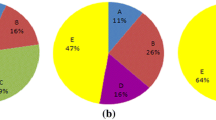Abstract
This paper develops a genetic algorithm for scheduling products with a multi-level structure. The proposed approach explicitly considers due dates of products, operation sequences among items, and capacity constraints of the manufacturing system. The objective of the approach is to seek the minimum cost of both production idle time and tardiness or earliness penalty of an order. A representative example is illustrated to compare the GA-based approach with mixed integer programming (MIP). The results demonstrate that the suggested approach is satisfactory in producing effective schedules.
Similar content being viewed by others
References
Billington PJ, McClain JD, Thomas LJ (1983) Mathematical programming approaches to capacity-constrained MRP systems: review, formulation and problem reduction. Manage Sci 29:1126–1141
Faaland B, Schmitt T (1987) Scheduling tasks with due dates in a fabrication/assembly process. Oper Res 35:378–388
Pongcharoen P, Hicks C, Braiden PM (2004) The development of genetic algorithms for the finite capacity scheduling of complex products, with multiple levels of product structure. Eur J Oper Res 152:215–225
MacCarthy BL, Liu J (1993) Addressing the gap in scheduling research: a review of optimization and heuristic methods in production scheduling. Int J Prod Res 31:59–79
Blazewicz J (1996) Scheduling computer and manufacturing processes. Springer, Berlin Heidelberg New York
Pinedo M (2002) Scheduling: theory, algorithms, and systems, 2nd edn. Prentice Hall, Upper Saddle River, New Jersey
Brucker P (2004) Scheduling algorithms, 4th edn. Springer, Berlin Heidelberg New York
Goodwin JS, Goodwin JC (1982) Operating policies for scheduling assembled products. Decis Sci 13:585–603
Russell RS, Taylor III BW (1985) An evaluation of sequencing rules for an assembly shop. Decis Sci 16:196–212
Fry TD, Oliff MD, Minor ED, Leong GK (1989) The effects of product structure and sequencing rule on assembly shop performance. Int J Prod Res 27:671–686
Reeja MK, Rajendran C (2000) Dispatching rules for scheduling in assembly jobshops—part 1. Int J Prod Res 38:2051–2066
Czerwinski CS, Luh PB (1994) Scheduling products with bills of materials using an improved Lagrangian relaxation technique. IEEE Trans Robot Autom 10:99–111
Agrawal A, Harhalakis G, Minis I, Nagi R (1996) ‘Just-in-time’ production of large assemblies. IIE Trans 28:653–667
Kim JU, Kim YD (1996) Simulated annealing and genetic algorithms for scheduling products with multi-level product structure. Comput Oper Res 23:857–868
Davis L (1991) Handbook of genetic algorithms. Van Nostrand Reinhold, New York
Mitchell M (1996) An introduction to genetic algorithms. MIT Press, London
Chambers L (1999) Practical handbook of genetic algorithms. CRC Press, Boca Raton
Gen M, Cheng R (2000) Genetic algorithms and engineering optimization. Wiley, New York
Bean JC (1994) Genetic algorithms and random keys for sequencing and optimization. ORSA J Comput 6:154–160
Goldberg DE (1989) Genetic algorithms in search, optimization, and machine learning. Addison-Wesley, Reading, MA
Hadj-Alouane AB, Bean JC (1997) A genetic algorithm for the multiple-choice integer program. Oper Res 45:92–101
Moon C, Kim JS, Gen M (2004) Advanced planning and scheduling based on precedence and resource constraints for e-plant chains. Int J Prod Res 42:2941–2954
Acknowledgement
The authors wish to acknowledge The Hong Kong Polytechnic University for the financial support of the project (G-RGF9).
Author information
Authors and Affiliations
Corresponding author
Rights and permissions
About this article
Cite this article
Chen, K.J., Ji, P. Development of a genetic algorithm for scheduling products with a multi-level structure. Int J Adv Manuf Technol 33, 1229–1236 (2007). https://doi.org/10.1007/s00170-006-0561-z
Received:
Accepted:
Published:
Issue Date:
DOI: https://doi.org/10.1007/s00170-006-0561-z




